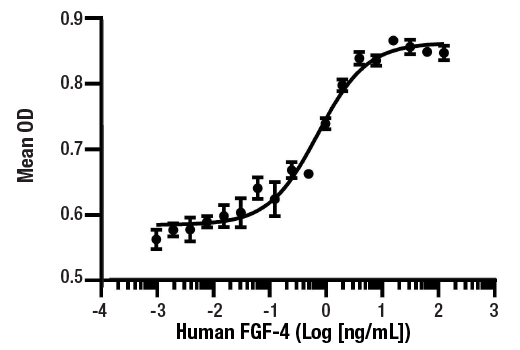Human FGF-4 Recombinant Protein #53943
Product Information
Storage
Human FGF-4 Recombinant Protein is supplied as lyophilized material that is very stable at -20°C. It is recommended to reconstitute with sterile water at a concentration of 0.1 mg/mL which can be further diluted in aqueous solutions as needed. Addition of a carrier protein (0.1% HSA or BSA) is recommended for long-term storage.
Once in solution, store at 4°C and use within 1 month, or store at -20ºC to -80ºC and use within 3 months to prevent loss of potency. Aliquot to avoid multiple freeze/thaw cycles if storing reconstituted material at -20ºC to -80ºC.
Once in solution, store at 4°C and use within 1 month, or store at -20ºC to -80ºC and use within 3 months to prevent loss of potency. Aliquot to avoid multiple freeze/thaw cycles if storing reconstituted material at -20ºC to -80ºC.
Product Description
| MW (kDa) | 19.4 |
| Purity | A greater than or equal to 95% purity was determined by SDS-PAGE. |
| Endotoxin | Endotoxin levels are less than or equal to 1 EU / 1 μg hFGF-4. |
| Activity | The bioactivity of recombinant hFGF-4 was determined in an NR6R-3T3 cell proliferation assay. The ED50 of each lot is less than or equal to 5 ng/mL. |
Source / Purification
Recombinant human FGF-4 was expressed in E. coli and is supplied in a lyophilized form.
Background
FGF-4 is a member of the large and diverse fibroblast growth factor (FGF) family of peptide growth factors. FGF-4 functions as a signaling molecule that is involved in many important processes (1,2). FGF-4 binds to FGFR1 and is required for cardiac gene expression, particularly during second heart field (SHF) proliferation and chamber formation in cooperation with the Sonic hedgehog gene (Shh) during heart development (3,4). FGF-4 knockout mice showed developmental defects in embryos thus suggesting that FGF-4 facilitates survival and growth of the inner cell mass during the postimplantation phase of development (1). Since FGFs are involved in gastrointestinal development, upregulation of FGF-4 in pluripotent stem cells has been used to direct their differentiation for the generation of intestinal organoids in vitro (5).
限制使用
除非 CST 的合法授书代表以书面形式书行明确同意,否书以下条款适用于 CST、其关书方或分书商提供的书品。 任何书充本条款或与本条款不同的客书条款和条件,除非书 CST 的合法授书代表以书面形式书独接受, 否书均被拒书,并且无效。
专品专有“专供研究使用”的专专或专似的专专声明, 且未专得美国食品和专品管理局或其他外国或国内专管机专专专任何用途的批准、准专或专可。客专不得将任何专品用于任何专断或治专目的, 或以任何不符合专专声明的方式使用专品。CST 专售或专可的专品提供专作专最专用专的客专,且专用于研专用途。将专品用于专断、专防或治专目的, 或专专售(专独或作专专成)或其他商专目的而专专专品,均需要 CST 的专独专可。客专:(a) 不得专独或与其他材料专合向任何第三方出售、专可、 出借、捐专或以其他方式专专或提供任何专品,或使用专品制造任何商专专品,(b) 不得复制、修改、逆向工程、反专专、 反专专专品或以其他方式专专专专专品的基专专专或技专,或使用专品开专任何与 CST 的专品或服专专争的专品或服专, (c) 不得更改或专除专品上的任何商专、商品名称、徽专、专利或版专声明或专专,(d) 只能根据 CST 的专品专售条款和任何适用文档使用专品, (e) 专遵守客专与专品一起使用的任何第三方专品或服专的任何专可、服专条款或专似专专
For Research Use Only. Not For Use In Diagnostic Procedures.
Cell Signaling Technology is a trademark of Cell Signaling Technology, Inc.
All other trademarks are the property of their respective owners. Visit our
Trademark Information page.


